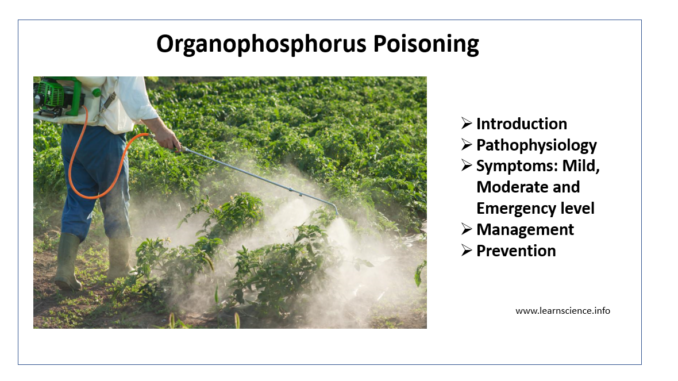
- Organophosphorus compounds constitute a heterogeneous category of chemicals used for controlling pests, weeds or plant diseases. Organophosphates are most commonly used pesticides.
- Chemically they are esters of phosphoric acid.

- Organophosphorus poisoning is an important clinical problem worldwide which is more prevalent in rural region of developing world. It is an important cause of morbidity and mortality, killing around 200,000 people every year.
- Organophosphorus poisoning may be occupational (in persons engaged in spraying insecticides), accidental (by consuming agricultural products sprayed with these insecticides) or suicidal (intentional ingestion).
Pathophysiology

- Organophosphorus pesticides inhibit esterase enzymes, mainly acetylcholinesterase. It results in accumulation acetylcholine which causes overstimulation of acetylcholine receptors in synapses of ANS, CNS and neuromuscular junctions.
Symptoms of organophosphorus poisoning
- The poisoning symptoms can range from mild to severe and depend on length and strength of exposure. Symptoms may start within few minutes or after several hours.
- Symptoms of mild to moderate exposure include:
- Blurred vision with watery or stinging eyes and narrowed pupil.
- Muscle tremors, twitching and muscle weakness.
- Extra salivation and drooling.
- Wheezing, sneezing and coughing.
- Severe diarrhea and vomiting.
- Uncontrolled urination or bowel movements.
- Headache, nausea and dizziness.
- Agitation and disorientation.
- Symptoms of emergency level exposure to organophosphate include:
- Narrow pupils.
- Confusion, agitation.
- Convulsion.
- Excessive secretions such as saliva, sweat, tears and mucus.
- Irregular or slow heartbeat.
- Collapsing.
- Coma.
Management of acute organophosphorus poisoning
- Patients with acute exposure should undergo immediate assessment and management of disturbances in airway, breathing and circulation to prevent fatal outcome.
- If intoxication is through mouth, patient should be placed in left lateral position with head lower than feet to prevent aspiration of stomach contents. Clear the mouth and pharynx with clean finger or suction. Mouth to mouth respiration should be avoided in such cases as vomited material may contain toxic amount of substances.
- If the body is soiled with insecticides or vomiting and hypersalivation occurs, clothes must be removed, and skin should be washed with soap and water for about 10 minutes. If eyes are exposed, conjunctiva should be washed with clean water.
- If signs of systemic absorption are observed, atropine and cholinesterase reactivators like oximes must be given parenterally.
- Depending on severity, 1-3 mg of atropine should be given as IV bolus. Set up an infusion of 0.9% normal saline. Record pulse rate, pupil size, blood pressure, presence of sweat and auscultatory findings while administering first atropine dose.
- Administer 1-2 gm of pralidoxime chloride or 250 mg of obidoxime chloride by slow IV injection. It should be followed by an infusion of pralidoxime 0.5-1 gm/hour or obidoxime 30 mg/hour in 0.9% normal saline.
- Patient should be checked every 5 mins after atropine administration for pulse rate, blood pressure, pupil size, sweat and chest sounds. If no improvement is seen, double the dose of atropine every 5 minutes. If some improvements are observed, stop increasing the dose. There are several cases, in which several hundred mg have been given during first 24 hours.
- Atropine should ne administered until heart rate is more than 80 beats/minute, systolic BP is more than 80 mm Hg and chest is clear.
- Once the stable condition is achieved, start an infusion of atropine every hour about 10-20 % of total dose needed to stabilize the patient. Monitor the patient regularly.
- Continue oxime infusion until atropine has not been needed for 12-24 hours and patient has been extubated.
- Access flexor neck strength in conscious patients by asking them to lift head off the bed and hold it in a position. Any sign of weakness indicates that patient is at risk of developing peripheral respiratory failure.
- Convulsions can be treated with diazepam. Benzodiazepines can ne used for agitation and seizures.
- Atropine is effective in antagonizing central and peripheral muscarinic effects but doesn’t affect neuromuscular paralysis and ganglionic action. Atropine should not be used in cyanosed patients until cyanosis is overcome as it may cause ventricular fibrillation.
- Oximes reverse neuromuscular blockade by reactivating inhibited acetylcholinesterase. Cholinesterase reactivators should not be administered before atropine as they cause muscle weakness when used alone.
- In some cases, after a gap of 2-4 weeks delayed polyneuropathy may occur characterized by sensory and motor impairment. It is due to release of fat soluble organophosphorus from fat stores. So, patients should be monitored frequently.
- They should not be allowed to do same work involving organophosphorus until plasma cholinesterase level exceeds 70 % of normal. It may take several weeks.
Prevention

- People who are in frequent contact with organophosphorus compounds should be careful while using it.
- It should be correctly stored and labelled properly to avoid unintentional exposure.
- People working in farm should wear protective gear during and after applying organophosphorus pesticides. Protective gear includes covering of head and neck, mask or respirator and eye protection.
- They should wash hands properly before eating, drinking, smoking and urinating and take thorough bath at the end of workday.
- For people living or working near farm that use organophosphates, staying indoor with windows shut can help to limit exposure.
- Washing of fruits and vegetables thoroughly before using helps to avoid unintentional exposure.
References
- Roberts DM, Aaron CK. Management of acute organophosphorus pesticide poisoning. BMJ. 2007; 334(7594): 629–634.
- Eddleston M, Buckley NA, Eyer P, Dawson Ah. Management of acute organophosphorus pesticide poisoning. Lancet. 2008; 371(9612): 597–607.
- https://www.medicalnewstoday.com/articles/320350#causes-and-risk-factors
- Pharmacology and Pharmacotherapeutics. 24th edition.